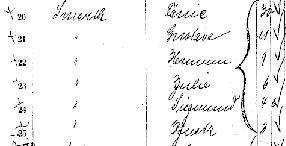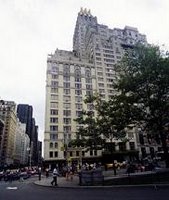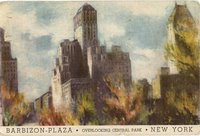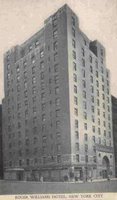 "The truth is, [Alfred Perles] had led so many lives, had assumed so many identities, had acted so many parts, that to give any hint of totality would have meant reconstructing a jig-saw puzzle. He was as bewildering to himself, to be honest, as he was to others."
"The truth is, [Alfred Perles] had led so many lives, had assumed so many identities, had acted so many parts, that to give any hint of totality would have meant reconstructing a jig-saw puzzle. He was as bewildering to himself, to be honest, as he was to others."
--- Henry Miller from
Remember To Remember"Floating, however, is not drifting. To float requires a kind of internal balance, to drift smacks of directionlessness."--- Alfred Perles, explaining the finer points of being a "floater" through life, from his
My Floating Life.
Updated December 28, 2007
I don't pretend to present you here with the ultimate Alfred Perles biography. The short blog format doesn't suit it, and my own status as an amateur means I am drawing from a limited source of second-hand information. I tracked down a copy of Perles's
My Floating Life, thinking I would get an autobiography. Unfortunately, it's merely a three-page booklet in which he elaborates on his philosophy of "floating" as an vital means of living one's life.

The book I should have bought was his rare "unfinished" autobiography Scenes From A Floating Life. When I manage to get this--and uncover any further biographical information--I will update this posting, so that some form of concise Perles biography exists on the net.
1898 - Perles is born in Vienna, Austria, to Czech parents: a Jewish businessman father and French Catholic mother. Childhood in The Schmeltz.
1914-18 - Serves as Junior Officer in Austrian Army under the Kaiser during WWI. After failing his duties in some way, he is sent off to an insane asylum instead of being shot; his father's influence may have helped save him.
1919/20 - Leaves home to become a writer against his parents' wishes. Travels to Berlin, where he leaves one of his earliest manuscripts called Luechtraketen with a hotel manager as a pawn for a 5 mark debt. He moves on to Switzerland, then finally arrives in Paris (as a Czech national). He is in a constant state of starvation, but learns how to survive; skills he will later pass on to Henry Miller.
 1920's - Struggles as a writer, but still travels to Prague, Copenhagen, Amsterdam, Italy, and Yugoslavia.
1920's - Struggles as a writer, but still travels to Prague, Copenhagen, Amsterdam, Italy, and Yugoslavia.
1926-7 - Works as a press agent (mostly in German publications) and assistant for photographer Brassai.
1927? - Fiancee Mara Andrews falls ill, breaks off their engagement.
1927 ? - Becomes a writer for the Port Edition of the Chicago Tribune. This includes profiles of artistic events in Paris. Meets June Mansfield Miller in Paris (doesn't like her much though she'll claim he had an interest in her), then runs off to North Africa with June's lesbian lover, Jean Kronski (Vanya in Crazy Cock).
1928 - Meets Henry Miller for this first time, on rue Delambre in Paris.
1930 - Becomes Miller's living-in-poverty mentor upon Henry's return to Paris. Together they write a joke manifesto called The New Instinctivism (A Duet In Creative Violence).
1931 - Gets Miller work on the Chicago Tribune Port Edition. Behind the landlord's back, Miller is invited to live with Perles at the Hotel Central. Fred is so broke that his typewriter is in hock.
1932-34 - The so-called Quiet Days In Clichy, during which Fred and Henry are roommates in Clichy, just outside of Paris. In the novel, Fred is referred to as "Carl," just as he will be in Tropic Of Cancer. Perles and Miller visit Luxembourg together.
1934 - During the summer, Fred attempts to have his novel Title To Follow published. Miller describes it as a "companion piece" to Tropic Of Cancer because it was written during the same time period and at the same place (in Clichy). It's biographical in nature and mentions Henry by name as a character. [Miller letter to Emil Schnellock, Aug. 28, 1934]
1934 - Meets Ezra Pound, who then (Perles claims) wrote of Fred's WWI expereinces in Canto XXXV (in which he is referred to as 'Mr. Corles.')
1935 - Miller writes What Are You Going To Do About Alf?, in an effort to raise money to send Alfred to Ibizia, where he could write in peace. (I'm not sure that he ever went; I will have to track down the 1971 edition of this piece, for which an epilogue was written by Perles [in 1968]). Perles contributes to the Hamlet letters along with Michael Fraenkel and Miller.

1936 - Writes his first French novel Sentiments Limitrophes.
1937-39 - Out of work due to closure of the Chicago Tribune Paris office, Perles takes a job running The Booster magazine for the Amercian Country Club of France. Perles, Miller, Lawrence Durrell and Anais Nin turn this into a literary enterprise of their own.
1938 - Second novel, Le Quatour En Re Majeur. With WWII on the horizon, Perles evacuates Paris for England.
1939 - Joins the British Army's Pioneer Corps, helping to clean up the rubble after the bombings of the Blitz. Around this time, he meets a Scottish woman named Anne Barrett, whom he'll evetually marry [in an issue of the Lawrence Durrell Journal, Anne wrote an essay called How I Met Fred.]
1943/44 - Now living in England, Perles writes his first book in English, The Renegade (with its autobiographical set-up: a Frenchman who has just moved to Britain). The novel wins a Book Society Recommendation. [Also see his Allez Sans Retour, Londres, and Round Trip]. Writes the story Alien Corn. Although his real and publishing name is Alfred Perles, he takes on Anne's surname and becomes Alfred Barret.
1946 - Contributes a piece for the series Why I Write in the short-lived Gangrel magazine; George Orwell also contributes. On the flap jacket to the 1947 edition of Orwell's anti-English The English People, Round Trip is referenced as a counterpoint, as a very pro-English book (Alf indeed loves England).
1947 - Becomes a naturalized British citizen. Around this time, he lives in Hampstead.
1950 - Perles marries Anne Barret in or around 1950 (his 1990 obituary states that he'd been married for "40 years"). They will later live in Rhodes and Cyprus for a short time.
1952/53 - Living in Wells, Somerset [seen at right] with his wife Anne. Henry visits them from his new home at Big Sur.
Mid-50s - Writes tributes My Friend Henry Miller (during a visit to Big Sur in 1954; published 1955) and My Friend Lawrence Durrell.
1959 - Perles, Miller and Durrell all reunite and vacation in Europe [ See Reunion In Barcelona].
1961 - Perles and Durrell publish a critique on Henry called Art And Outrage.
1960s - Employed as a messanger for Reuters in London.
1967-68 - My Floating Life [quoted at top] is written in Chania, Crete (but only published in limited edition in 1973). The 36-page Scenes From A Floating Life is published by Turret Press in London (less than 250 copies).
1980s - His two French novels are re-issued. To coincide with their release, Perles becomes a subject for French media.
1987 - Publishes an English translation of Rilke's The Lay of Love and Death. This was adapted into a musical piece, which is performed in Holland in 1989.
1990 - Dies on Janury 27th, age 92, in Somerset. According to this old posting on the Henry Miller Library message board, he was cremated and his ashes scattered in Bath, England.
The portrait photo of Perles in the banner above is credited to Wynn Bullock. The image of him on the right of the same banner graphic is credited to Rupert Pole.
Some of this biographical information was updated on December 28, 2007, to conform to the Alfred Perles obituary published in The Guardian (London), January 30, 1990.

 On June 26, 1908, six-year old June, her mother, and four siblings boarded the President Lincoln [pictured left] in Hamburg. The ship was built in 1903 and went through various names before being christened President Lincoln in 1907. It was later entered into service during WWI and was sunk at the end of the war [a detailed history of the ship can be found here and here].
On June 26, 1908, six-year old June, her mother, and four siblings boarded the President Lincoln [pictured left] in Hamburg. The ship was built in 1903 and went through various names before being christened President Lincoln in 1907. It was later entered into service during WWI and was sunk at the end of the war [a detailed history of the ship can be found here and here]. 

 From the Naturalization Record refered to by Robert Ferguson, we know that June had brothers and sisters: Maria Augusta, Herman, Sigmund, and Edward. Besides June, four children are listed as being a "child" of "Tanie": Gustava (11), Herman (9), Sigmund (4) and one I just can't read (3) [ref. 1 above].
From the Naturalization Record refered to by Robert Ferguson, we know that June had brothers and sisters: Maria Augusta, Herman, Sigmund, and Edward. Besides June, four children are listed as being a "child" of "Tanie": Gustava (11), Herman (9), Sigmund (4) and one I just can't read (3) [ref. 1 above].
 The photo at the top of this posting was taken circa 1930 by
The photo at the top of this posting was taken circa 1930 by 
























